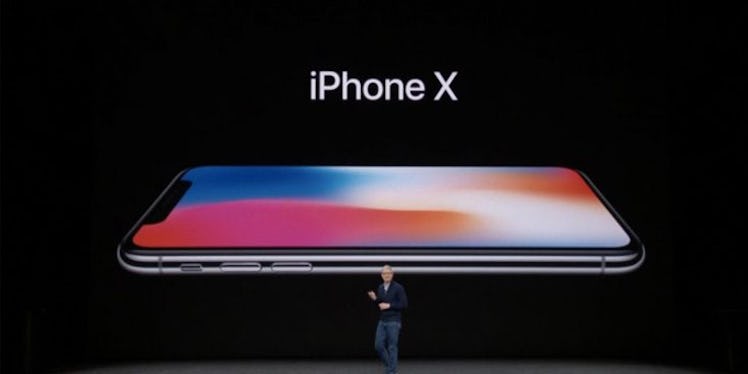After 10 years of iPhones, Apple has outdone itself with the iPhone X. The sleek, high-end smartphone has an array of futuristic features, including wireless charging, a super high-resolution screen, and facial recognition technology. That's right: iPhone X's Face ID will allow users to secure their phones, send animated emojis, and even use Apple Pay -- all by looking at their phones. But how does the iPhone X's Face ID work? The kinda cool, kinda creepy technology scans and makes 3D face maps, and it seems like a plot line right out of Black Mirror.
Face ID uses something Apple calls the True Depth camera system. It's a set of sensors built into the bar along the top of the iPhone. True Depth uses a dot projector, an infrared camera, an ambient light sensor, a proximity sensor, and a flood illuminator in concert in order to scan user faces. True Depth first projects a grid of 30,000 invisible light dots onto the user's face. Infrared will then capture the distortion of those dots, creating a 3D map of your face.
According to Gizmodo, Face ID gets better at recognizing its user every time it scans, and the technology will be able to recognize its user even with slight facial changes such as the addition of hats or glasses.
These sensors are powered by an A11 Bionic chip, a high-efficiency chip that, in the instance of Face ID, improves pixel processing, handles high-speed image processing, and protects Face ID data. The high-efficiency chip is, in part, what allows True Depth to scan faces in order to create animojis -- emojis that are animated based on the user's facial expressions.
But Apple's new technology is also raising questions about the necessity of such a feature.
According to an Apple press release, "The [infrared] image and dot pattern are pushed through neural networks to create a mathematical model of your face and send the data to the secure enclave to confirm a match, while adapting to physical changes in appearance over time."
At the Sept. 12 keynote, Apple announced that there's a "1 in 1,000,000 chance" of your phone being hacked.
These maps are stored in a database which Apple says is secure. But Apple has been hacked in the past: once, in 2013, and allegedly once more in March 2017, which Apple denies. Additionally, iPhones are surprisingly easy to hack into, and only a few months ago, Apple had to release a patch for iOs 10 to fix vulnerability to something called Broadpwn, which made it possible to hack Apple devices through wifi chips in the main processor.
Additionally, facial recognition technology on some laptops has been handily defeated, according to Wired. So some have questioned whether or not the promised security of Face ID is sufficient. But as Wired pointed out, Face ID is a much more sophisticated technology that employs 3D mapping, and it'll be much more difficult to fool.
And still, others have a more dystopian view of the technology:
But those who are concerned should keep in mind that Face ID only unlocks for attentive faces. In other words: if you're not looking at the camera, or if your eyes are closed, your phone will remain locked.
Still, Matthew Segal, a civil rights lawyer and the legal director for ACLU Massachusetts put together a handy thread on what law enforcement can and cannot do with Face ID. The long and short of it: police still need a warrant to unlock your phone, but there is still concern over the ease with which they could illegally search your phone with Face ID.
For now, I'm going to stick to my nice, boring passcode.
